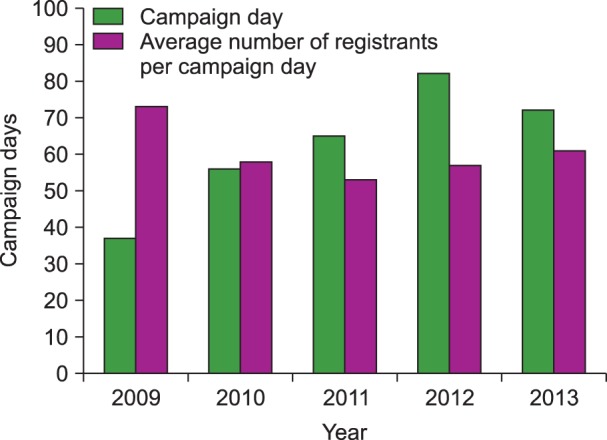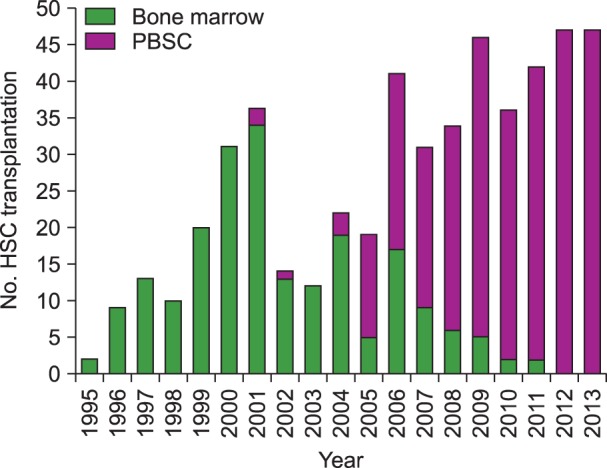Blood Res.
2016 Jun;51(2):107-112. 10.5045/br.2016.51.2.107.
Unrelated hematopoietic stem cell registry and the role of the Hematopoietic Stem Cell Bank
- Affiliations
-
- 1Catholic Hematopoietic Stem Cell Bank, College of Medicine, Catholic University, Seoul, Korea. kimtg@catholic.ac.kr
- 2Department of Nursing, Namseoul University, Cheonan, Korea.
- KMID: 2309212
- DOI: http://doi.org/10.5045/br.2016.51.2.107
Abstract
- BACKGROUND
The hematopoietic stem cell bank has been actively recruiting registrants since 1994. This study systematically reviews its operations and outcomes over the last 20 years.
METHODS
Retrospective data on a total of 47,711 registrants were reviewed. Relevant data were processed using PASW Statistics for Windows, version 18.0.
RESULTS
As of 2013, the Korean Network for Organ Sharing database contained 265,307 registrants. Of these, 49,037 (18%) registrants committed to hematopoietic cell donation from 1994 to 2013. Fifty-seven percent of the registrants were men, and 43% were women. The reasons for opting out of the registry included refusal to donate (70%), family refusal (28%), and others (2%). The donation willingness of registrants was significantly higher than those who refused to receive a mail to confirm their continued enrollment (χ2=6.103, P=0.013). The bank successfully coordinated a total of 512 donors among newly matched donors from 1995 to 2013, of which the bone marrow and peripheral blood stem cell accounted for 40.8% and 59.2% of the total donations, respectively.
CONCLUSION
Our recruitment activities focus on promoting voluntary registration and the importance of updating personal contact information. We expect that these data may be useful for diverse studies and demonstrate the positive impacts on the donation program.
Keyword
MeSH Terms
Figure
Reference
-
1. Thomas ED, Lochte HL Jr, LU WC, Ferrebee JW. Intravenous infusion of bone marrow in patients receiving radiation and chemotherapy. N Engl J Med. 1957; 257:491–496. PMID: 13464965.
Article2. Kim JA. New therapeutic modalities on hematopoietic stem cell transplantation. Korean J Med. 2010; 78:552–556.3. Copelan EA. Hematopoietic stem-cell transplantation. N Engl J Med. 2006; 354:1813–1826. PMID: 16641398.
Article4. Ballen KK, King RJ, Chitphakdithai P, et al. The national marrow donor program 20 years of unrelated donor hematopoietic cell transplantation. Biol Blood Marrow Transplant. 2008; 14(Suppl 9):2–7. PMID: 18721774.
Article5. Chung NG. A study of post-hematopoietic stem cell transplant management. Cheongju, Korea: Centers for Disease Control and Prevention;2012. Accessed October 4, 2015. at http://www.cdc.go.kr/CDC/info/CdcKrInfo0201.jsp?menuIds=HOME001-MNU1154-MNU0004-MNU1889&fid=28&q_type=&q_value=&cid=25523&pageNum=1.6. Kim YJ, Kim DW, Lee S, et al. Outcomes of unrelated allogeneic stem cell transplantation: single center experience. Korean J Hematop Stem Cell Transplant. 2003; 8:77–84.7. Hwang TJ. Hematopoietic stem cell transplantation: overview for general pediatrician. Korean J Pediatr. 2007; 50:613–621.8. Oh MS. Lifesaving awareness report. Sejong, Korea: Ministry of Health and Welfare;2011. Assessed October 13, 2015. at http://www.mohw.go.kr/front_new/jb/sjb030301vw.jsp?PAR_MENU_ID=03&MENU_ID=0328&CONT_SEQ=265210&page=1.9. Lee YH. Development of management model to increase wouldbe donor participation. Cheongju, Korea: Centers for Disease Control and Prevention;2011. Assessed October 13, 2015. at http://www.cdc.go.kr/CDC/info/CdcKrInfo0201.jsp?menuIds=HOME001-MNU1155-MNU1083-MNU1375-MNU0025%20&fid=28&q_type=&q_value=&cid=1687&pageNum=1.10. Be the Match. Medical guidelines – who can join? Minneapolis, MN: The National Marrow Donor Program;2014. Accessed December 2, 2015. at http://bethematch.org/support-the-cause/donate-bone-marrow/join-the-marrow-registry/medical-guidelines/.11. Laithy H. Be the match. Become a bone marrow donor. North Dartmouth, MA: The Torch Constitution;2012. Accessed October 24, 2015. at http://www.umasstorch.com/index.php?option=com_k2&view=item&id=1446:be-the-match-become-a-bone-marrow-donor&Itemid=156.12. Kim HJ. HLA mismatched allogeneic hematopoietic stem cell transplantation. Korean J Hematol. 2007; 42:1–14.
Article13. Hershberger PE, Finnegan L, Altfeld S, Lake S, Hirshfeld-Cytron J. Toward theoretical understanding of the fertility preservation decision-making process: examining information processing among young women with cancer. Res Theory Nurs Prac. 2013; 27:257–275.
Article14. Ministry of Health and Welfare. The law on the management and research of umbilical cord blood. Sejong, Korea: Ministry of Health and Welfare;2012.15. Kim HJ. Hematopoietic stem cell (blood and marrow). . Seoul, Korea: Seed of Hope, Policy Magazine;2011. 1:p. 36–37.
- Full Text Links
- Actions
-
Cited
- CITED
-
- Close
- Share
- Similar articles
-
- Hematopoietic Stem Cell Transplantation
- Opening the era of in vivo xenotransplantation model for hematopoietic stem cell transplantation
- Proposal for an Ideal Management System for Hematopoietic Stem Cells in Korea
- Hematopoietic Stem Cell Transplantation in Inborn Error of Metabolism
- Current Status for Cord Blood Transplantation and Public Cord Blood Bank in Korea



